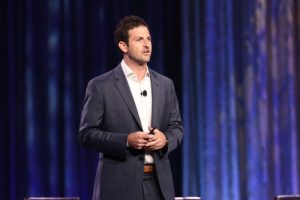
Historically, generations could expect to experience one – maybe at best – major technology disruption or transformation in their lifetime. That’s simply not the case today. Today it is more difficult than ever before to know what will transform the technology landscape in the next month or the next year. And that dilemma is what Jared Cohen, president of Jigsaw, calls “the new world disorder.” Cohen took the main stage at Analytics Experience 2016, to explore the unparalleled advances and unprecedented threats we need to be prepared for as the physical and digital worlds merge.
“Technology is changing the world, but the world is also changing technology,” said Cohen. “But while those changes are extraordinary, they only tell us a fraction of what’s happening. We really need to be asking ourselves how all of this technology is impacting our world.”
Consider North Korea, a place where citizens receive the death penalty if caught with a smartphone, yet tens of thousands still risk their lives daily to have access to mobile devices. At the same time, in Brazil, where the Amazon jungle is being used by criminals and traffickers to hide slave-labor camps, drones are being used to fly over the jungle to uncover such camps, and in the last year 700 camps have been discovered. These environments force us to rethink the power of technology, its capabilities and the risks and lengths people will go to maintain access to the digital world.
The new global disorder
Technology is changing the world around us in a way that only happens every couple of centuries. The disruption we are seeing is on par with the level of change the world experienced from the Renaissance, from the Age of Enlightenment or from the Industrial Revolution. It’s a change that forces us to think differently.
“We can no longer analyze the physical and digital worlds separately, or we will completely miss what’s really taking place in our society,” said Cohen. “We have to think of the world holistically and understand that every physical space has a corresponding digital space.”
What better place to start blending the physical and digital worlds than with power? What previously used to be strictly politically, economically, militarily or socially driven, has now reached new heights with the newest power variable – a country’s cyber capacity. Cyber power comes down to a country’s indigenous ability to build products, leverage human talent, maintain access to capital and ensure a regulatory environment that’s ripe for innovation.
These are the new power players all companies are chasing, and while they bring endless opportunities, there are also inadvertent digital risks that come from a growing cyber footprint. “When the world was solely abiding by physical powers it was still difficult to ensure people followed rules and borders,” said Cohen. “But how much more of a challenge will it be given today’s digital factor; it makes everything more complex.”
If Russia can hack into American election systems and China can steal millions of personally identifiable records of US citizens, where does it stop and where does the threshold lie where cyber-driven power attacks become so egregious that it warrants a physical attack?
Do you have a digital health care plan?
In a digital world, where people have multiple phone numbers, email addresses and social channels, we’ve unintentionally created a virtual entourage of ourselves. “Our identity today encompasses what people say, what people post and what photos are shared,” said Cohen. “All of that has moved us from owners of our identities to managers and curators.”
Given the role shift over our own lives, the question becomes, “Why aren’t we taking more precaution to protect ourselves digitally like we would manage and protect our physical health?” Cohen challenged attendees to think of cybersecurity as an extension of our physical security. It is essential that we focus on protecting our digital domain – it will last longer than the physical and may matter more in the end.
Wrapping up his keynote presentation, Cohen noted that it would be dishonest to say technology is only a force of good, because while technology is positive, the world is still a nasty place. However, he said, “People can say that the world looks its worst right now, but that’s not the case. “Technology is giving us more visibility into the world than we’ve had in any other time in history. While it looks like bad news, the fact is that we’ve never been more prosperous or safe.”
So while technology’s visibility might make us a bit uncomfortable, it is real and it’s a positive sign for the future.
View Cohen’s full talk: New World Disorder: Change and Chaos in the New Digital Age
